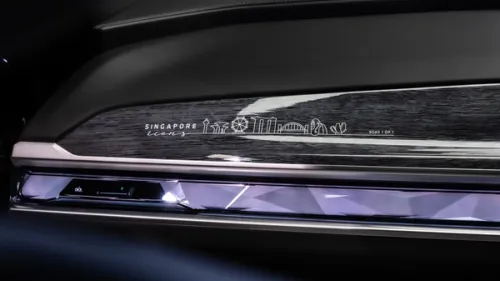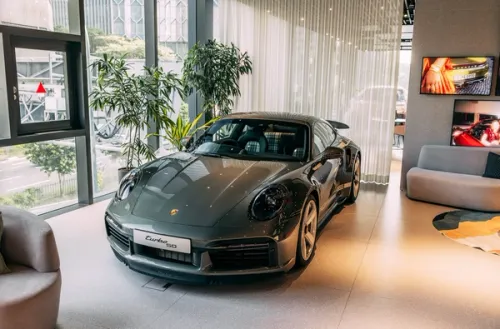
The McLaren P1™, which debuted in production form at the Geneva Motor Show, has been launched to a select few right here in Singapore. With the P1, Mclaren has a clear goal – to make the P1 be the best driver’s car in the world on road and track. To achieve this objective, McLaren has fully utilised its 50 years of racing experience and success, especially in the fields of aerodynamics and lightweight carbon fibre technology, creating a car with huge amounts of downforce for a road vehicle; the P1’s downforce levels are similar to that of a GT3 racing car, with even greater ground effect. This downforce not only boosts cornering and braking performance. It also helps balance, stability and driveability at all speeds.
The design team worked to a brief of ‘light and agile’. The design had to be ‘shrink wrapped’ around the mechanicals, making the car as compact and lightweight as possible. Even the number of body panels – all made from lightweight carbon fibre – was kept to a minimum. The strong carbon construction means they can ‘multi-task’ – acting as aero-honed ducts and load-bearing supports. They are intricately shaped yet superbly finished, helped by their strong carbon construction. There are only five main panels: front clamshell, front bonnet, rear clamshell and the doors.
The super lightweight shell sits very low to the ground indeed-just 1,138mm height in Race mode. The P1 also has a smaller frontal area than the (already small) 12C, and smaller than any other series production super sports car. The drag coefficient is kept at a lowly 0.34, which is very low indeed, considering the downforce one gets.
The McLaren P1™ is equipped with a twin turbo V8 similar to the one in the 12C, although in the P1’s application, the V8 is coupled with an electric motor. The combo gives the P1 very high levels of power, instant torque and terrific fuel and CO2 figures. The result is a powertrain that feels like a very strong, normally aspirated engine.
The twin-turbo petrol V8 and single electric motor – both mounted behind the cockpit in a mid-engine position – have a combined output of 916PS (900 hp) and 900Nm, with emissions of less than 200g/km. Power is driven to the rear wheels through a seven-speed dual clutch gearbox.
The P1 is equipped with Mclaren’s latest hydro-pneumatic RaceActive Chassis Control (RCC) system, which decouples roll and heave stiffness, and can also vary ride height. This system gives major advantages in ride, handling and grip, and can be changed by the driver to suit personal preferences. Handling and comfort can both be optimised, without the usual dynamic trade-offs.This system controls all four wheels are independently, with each having its own actuators with pistons for two different circuits, one for roll and one for heave, meaning these functions are separate. Decoupling these dynamic situations improves ride and handling.
The damping is adaptive, controlling suspension movement proactively, always ensuring an excellent balance of ride comfort, grip and handling. There are four suspension settings – Normal, Sport, Track and Race modes. The first three settings are selected via a rotary switch. Race mode is selected via a button on the fascia.
Inside the two-seat cabin carbon fibre is used for the dashboard, floor, headlining, doors, rockers and a single piece is shaped for the central control unit to further optimise weight. It is the lightest possible material, while offering the strength desirable for safety and structural integrity.
The amount of trim covering within the cabin has been minimised, leaving as many parts as exposed as possible. There is no interior sound deadening in order to optimise weight saving even further. Carpet is offered, as an option, but when chosen, it is fitted with a special lightweight backing.
The racing bucket seats use the minimum amount of foam, are encased in ultra-thin carbon fibre shells, and mounted on lightweight brackets and runners, contributing to an overall weight of just 10.5kg each. The seat backs are set to 28 degrees from the vertical, and there is manual fore/aft adjustment. The decision was taken to not offer separate adjustment to the seat backs, or electric adjusters to the base, as these would have added further weight. The height of the seat will be custom set to suit the driver and passenger, and can be subsequently adjusted in the workshop. The seat back can be set to 32 degrees for racing, as it will give more helmet head room. Fixings for a six-point race harnesses are in place, in addition to the standard inertia reel seat belts.
The interior of the McLaren P1™ feels like the cockpit of a fighter jet, complete with glass canopy overhead and, with a windscreen deeper than it is wide, visibility is optimised. Good side and rear visibility contrast with many other ‘supersports’ cars, which typically offer more a peek than a panorama. ‘
Credits:


Get the Best Price for your used car
from 500+ dealers in 24 hours

- Convenient and Hassle-Free
- Consumer Protection
Transparent Process
With No Obligation









